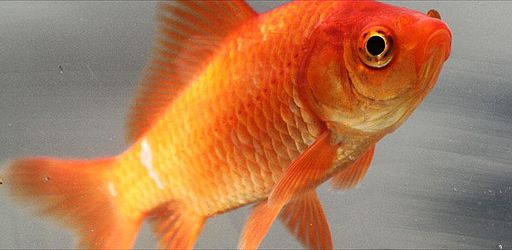
See how many of them you still believe
We’ve already talked about one of the biggest science fallacies that most of us still believe – the idea that humans only have five senses. As it turns out, there are plenty more to cover.
1. Goldfish have a 3-second memory
Image credit: Common goldfish by Bjwebb via Wikimedia Commons. Licensed by CC.
It’s actually surprising that this one stuck around for as long as it did since it's pretty easy to disprove. Basic experiments performed with goldfish demonstrated Pavlovian conditioning. The fish in the experiment would receive food under certain circumstances (normally in association with another object). After several instances, it became clear that the fish learned to associate the two together, showing that their memories last for at least several days.
2. Everest is the tallest mountain on Earth
Image credit: Mauna Kea by Vadim Kurland, CC-BY-SA-2.0 via Wikimedia Commons
Ok, this is a technicality, but it's a good fact to know if you want to be a smartass. The tallness of a mountain refers to its length from base to summit. The height refers to the length from sea level to summit. So, with that in mind, Mount Everest might be the highest mountain in the world, but it’s not the tallest. At 33,465 ft (10,200 m), Mauna Kea in Hawaii is taller than Everest which is “only” 29,029 ft (8,848 m). However, almost two-thirds of Mauna Kea is underwater.
3. Lightning never strikes the same place twice
Over the years, this saying has taken on a more figurative meaning but there are still those who consider it literal. There is no reason why we should believe such a thing. Lightning strikes the Earth anywhere from 50 to 100 or more times…per second (different sources claim different numbers). That’s over 1.5 billion times per year. The chances that one area would never be hit twice are incredibly small. Moreover, we know for a fact that places that have been struck multiple times. Tall buildings are very good at attracting lightning. The Empire State Building in New York gets struck dozens of times each year.
4. People in the Middle Ages thought the Earth was flat
Image credit: Flat-Earth Map by Orlando Ferguson via Wikimedia Commons. Licensed by CC.
Actually, it’s been known that our planet is round ever since the Ancient Greek time period (and possibly even sooner than that). If you want to be even more precise, Earth is actually an oblate spheroid because it is flatter at the poles than at the equator.
5. Sharks don’t get cancer
We already kill millions of sharks every year just to get their fins for shark fin soup. Now, sharks are also unfortunately hunted for their cartilage which can supposedly cure cancer. The problem is it can’t. At no point did scientists believe such a claim, but the general public was more eager to indulge the fantasy because of the incredible positive effects it would have on society. However, now we have definitive proof of sharks with tumors so the notion can be put to bed once and for all.
6. Most of your body heat escapes through your head
Image credit: U.S. Fish and Wildlife Service via Wikimedia Commons. Licensed by CC.
Various reasons have been given for this idea (such as the lack of fat in your head compared to other body parts). However, the truth is that you will lose just as much heat through your head as you do through the rest of your body, without accounting for isulation like clothing. However, unless you have a tendency to stroll naked through the snow during winters, your body is not clothed equally. Normally, your head is the only exposed part of your body which is the simple (and obvious) answer to why it is colder than the rest of your body.
7. Blood inside your body is blue
Image credit: ICSident at German Wikipedia, CC-BY-SA-3.0 via Wikimedia Commons
This one seems pretty obvious. After all, you can look at your veins right now and see blood passing through them and they look blue, right? This lends credence to the myth that deoxygenated blood is blue, but as soon as it exits the body and is exposed to oxygen, it turns red. This is not true because human blood contains hemoglobin at all times, even when it doesn’t contain oxygen. Hemoglobin is a red protein, so the blood in your body is actually a dark red. Veins appear blue due to how light is reflected.
8. The Great Wall of China can be seen from space
Image credit: Great Wall by Ahazan via Wikimedia Commons. Licensed by CC.
Another myth claims that the Great Wall of China is, in fact, the only man-made object that can be seen from space. In this case, it is doubly wrong. It all depends on what you mean by space. In low orbit, the wall can barely be seen, but so can a ton of other stuff we’ve made. From further back like the moon, you’ll be having trouble making out entire continents, let alone a wall.
9. Chameleons can change colors to blend in
Image credit: Chameleon by David Udvardy, CC-BY-SA-3.0 via Wikimedia Commons
Chameleons are pretty awesome and interesting. However, the idea that they camouflage themselves by blending into their backgrounds is a myth. In short, there are multiple reasons why a chameleon would change color and it depends on the species. Their mood and their intentions play a large role. If a chameleon is happy and courting a lady chameleon, he’ll change color. If he is angry and getting ready for a fight, he’ll change color again. External factors such as temperature also play a role.
10. Pluto is a planet
Image credit: Planets by Lsmpascal, CC-BY-SA-3.0 via Wikimedia Commons
Pluto lost its status as a planet a few years back, but some people didn’t get the memo and still believe in the nine-planet solar system model. But why is Pluto a dwarf planet now? Well, Pluto never really fit in with the rest of the planets. It is far smaller than all of the other rocky planets. As our telescopes got better, we started discovering more and more objects that were similar to Pluto in size. Should they be counted as planets, too?
Everything would have been fine as long as we didn’t find one object which is bigger than Pluto. However, that is exactly what happened when we discovered Eris so a decision had to be made. If Pluto is a planet, so is Eris (and most likely a few others, too), which means that even if we still kept it as a planet, the nine-planet model would still be obsolete. That is why it was demoted to dwarf planet along with Eris, Ceres, Haumea and Makemake, and it is highly likely that they are not alone. We already have hundreds of other potential candidates that need to be confirmed.







